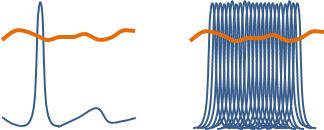In this book Nielsen sets out his argument for a new collaborative, collective, open way of doing science. This new approach is facilitated by the internet. Others have decried the effect the Web is having, but Nielsen says that's because we don't know how to use it to betst advantage yet.
In arguing his thesis, he starts some fascinating examples of how a networked collaboration surpassed the best experts: a chess match with a team of players collaborating against Garry Kasparov, and an online collaboration to develop a mathematical proof. The chess match is particularly interesting, because Nielsen ses it to highlight the idea of "micro-expertise".
... the World Team had such a diverse collection of talent available that each time a problem arose, a member of the team rose to the occasion; someone with just the right microexpertise would leap in to fill the gap.
This forcefully reminded me of a cartoon that Jack Cohen has often shown during one of his talks, which shows a gathering where a professor is being introduced as an expert on crocodiles eyelids; he modestly demurs, saying he is only an expert on the upper eyelids.
 One micro-expert is not enough. They would out-perform the expert
in only one small place, leaving the expert to dominate everywhere else.
But sufficient diverse micro-expertises,
can combine to dominate the expert everywhere.
The "expert" is then revealed to be merely a "Jack of all trades; master of none".
One micro-expert is not enough. They would out-perform the expert
in only one small place, leaving the expert to dominate everywhere else.
But sufficient diverse micro-expertises,
can combine to dominate the expert everywhere.
The "expert" is then revealed to be merely a "Jack of all trades; master of none".
However, this simple linear patchwork combination of expertises does not capture the whole picture Nielsen lays out. There is an extra facet to a collaboration: other people's ideas spark new ideas we might not have had on our own, sparking new ideas in them, with a positive feedback that amplifies the overall effect.
What is needed is the tools to harness and coordinate the relevant micro-expertises. This is where the internet comes in.
Nielsen analyses a range of collaborative internet projects, including Linux, Galaxy Zoo (a collaborative effort to classify images of galaxies), and Foldit (protein folding and other puzzles). He identifies:
This networked structure has changed the way at least some disciplines work. So, in programming, for example, there is no longer the "heroic" single developer, reinventing everything from the ground up. Instead:
This new style leads to another concept: that of the "micro-contribution", where an individual's contribution to the overall project may be just a single line of code in an Open Source project, or a single line of text in a wikipedia article.
This all sounds marvellous, but does it really mesh with our experience of how the world works? Groups of people in committees and the like are notoriously bad at collective intelligence. ("A committee is a life form with six or more legs and no brain."):
Given this, what distinguishes the examples that Nielsen describes, where the collective effort demonstrably does work better?
That is, they are the kind of problem domains that have shared knowledge and techniques, that have a shared recognition of the right answer, and a shared agreement on that fact. Nieslen argues that if there is a shared praxis (such as in chess, mathematics, and science), then it is possible to have scalable collective intelligence.
Having discovered which problems can benefit from amplified collective intelligence, and talked about how collective tools can aid this process, the next obvious question is: will anyone bother? Is there enough effort available to perform the scaling? It takes a lot of "citizen science" effort to classify all those galaxies, fold all thos proteins, and so on. Or does it?
So there is plenty of effort available. The total effort invested in one major football match (not including the travel time, or all the people watching on TV) is the same order of magnitude as an entire citizen science project that has made multiple discoveries, and will make more.
So Nielsen has established that certain problem domains, including science, can benefit from scalable collective intelligence. This promises great benefits to the advancement of science. But there is a cultural problem. Open science requires a commitment, and effort, to providing infrastructure, from collaborative tools to open scientific data. Yet that effort is "invisible" to the traditional scientific evaluation process, which rewards only one specific form of openness: publications.
So the final part of Nielsen's book is some suggestions of how the required culture change can be achieved. We can each play our individual part by making sure we credit infrastructure and data sources, but it will also require some top-down and collaborative initiatives. It won't be easy, but the benefits will be well worth it.
This is an important book, making crucial observations about how the practice of science can benefit from networking and openness. It is also very well written, and along the route of the argument is peppered with fascinating little insights, such as how the digital and linear DNA can encode complex shapes:
Recommended.
